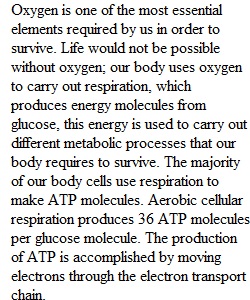


Q 1. Drowning, suffocation and carbon monoxide poisoning can lead to death because they all prevent oxygen from reaching our cells. Explain how this lack of oxygen can lead to death; be specific about how this lack of oxygen can affect cellular metabolic processes. 2. Glycolysis would quickly halt if the process ran out of _____, which serves as the hydrogen and electron acceptor. a. NADP+ b. ADP c . NAD+ d. H20 3. The ultimate electron acceptor in aerobic respiration is ______________. a. NADH b. CO2 c. O2 d. ATP 4. When glucose is used as an energy source, the largest amount of ATP is generated by the ________________ portion of the entire respiratory process. a. glycolytic b. acetyl-CoA formation c. Kreb’s cycle d. Electron transport chain e. aerobic 5. Starting with one molecule of glucose, the "net" products of glycolysis are: a. 2 NAD+, 2 H+, 2 pyruvate, 2 ATP, and 2 H2O. b. 2 NADH, 2 pyruvate, and 2 ATP. c. 2 FADH2, 2 pyruvate, 4 ATP, and 2 H2O. d. 6 CO2, 6 H2O, 2 ATP, and 2 pyruvate. e. 6 CO2, 6 H2O, 36 ATP, and 2 citrate. 6. The graph shows the rate of an enzyme reaction at different levels of acidity or alkalinity (pH). From the graph, what is the optimum pH for this enzyme? A. pH 2 B. pH 7 C. pH 10 D. none of these. 7. Pyruvic acid can be regarded as the end product of _________________. a. glycolysis b. acetyl-CoA format c. fermentation d. the Kreb’s cycle 8. The rate of glycolysis is_____________. a. stimulated by ATP b. stimulated by ADP c. inhibited by ADP d. inhibited by oxygen 9. Including the conversion of pyruvate to acetyl CoA, how many NADH, FADH2, ATP, and GTP molecules are produced during the Kreb’s cycle? NADH - Number of Molecules ______ FADH - Number of Molecules ______ ATP - Number of Molecules ______ 10. Fill in the table below to indicate how fermentation (lactic acid and alcoholic) is different from glycolysis and how the two pathways are similar. Glycolysis Fermentation Where in the cell do these processes take place? What are the reactants? What are the products? Is carbon dioxide produced? Can it occur in the presence of oxygen? Can it occur in the absence of oxygen? 11. What is the relationship between cellular respiration and photosynthesis based on their reactants and products? You will have to include the reactants and products of both processes in your answer. 12. ATP is the molecule that is used to provide energy necessary to power cellular functions, and as a result, it is often called the “energy currency” in the cell. How might this “energy currency” be saved; meaning, what organic molecule can be produced and later used to provide ATP? And what organic molecule might be considered the paycheck; the molecule that is “cashed” in order to get ATP quickly? Explain both your answers. 13. With the massive amount of plant life, ample rainfall and favorable temperatures, you might think that tropical rainforests would be large net producers of oxygen, and yet surprisingly, they are not! With your knowledge of photosynthesis and cellular respiration, can you explain why this might be true? Think about what happens when a leaf drops or fruit from a tree is eaten. The following Grading Rubric will be used to score your homework: Questions Expectation Points 1 Understands the role oxygen plays in cellular respiration and the consequences of the lack of it. 0-4 2-9 Understands the concepts of cellular respiration and enzyme activity (2 pts each). 0-16 10 Clearly differentiates between Glycolysis and fermentation. 0-6 11 Explains the relationship between photosynthesis and cellular respiration. 0-4 12 Explains the various forms of “energy” available to a cell. 0-4 13 Applies knowledge of photosynthesis and cellular respiration. 0-4 TOTAL {{{{{{{{{{ 38 pts PreviousNext
View Related Questions